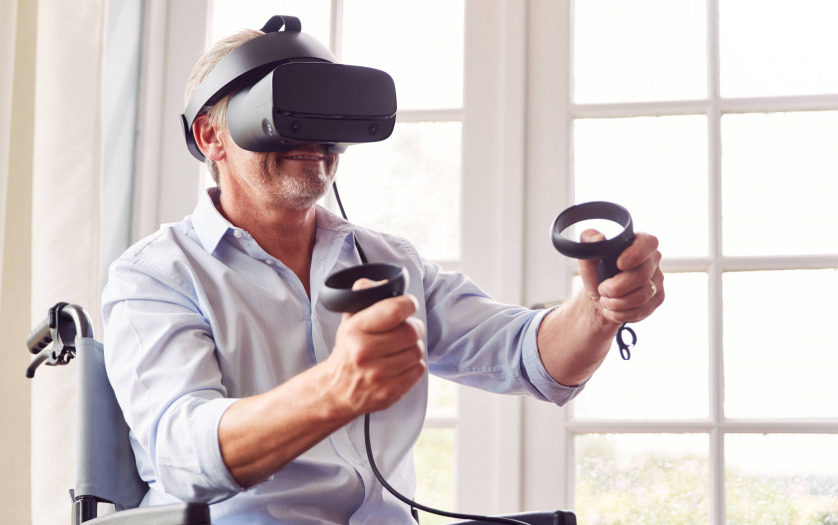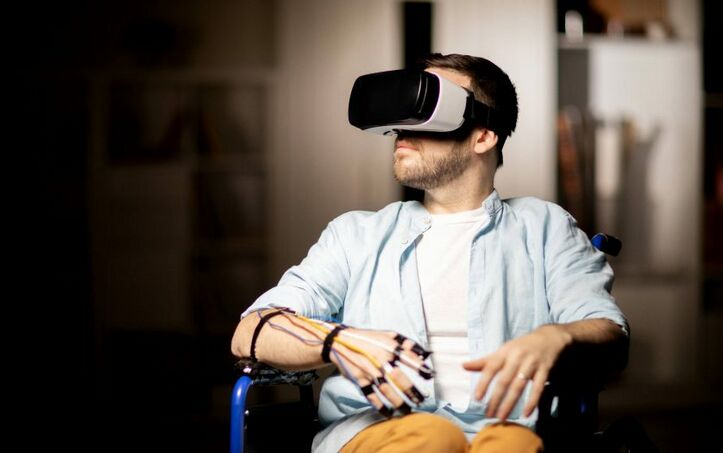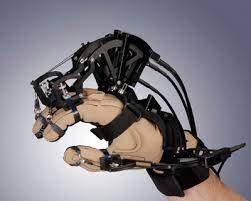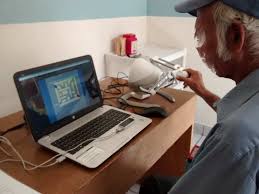Haptics in Stroke Rehabilitation
Introduction[edit | edit source]
Stroke is one of the leading causes of disability that results in minor to severe impairments. Post-stroke sequelae comprise impairments such as loss of range of motion, muscle weakness and motor deficits resulting from impaired force generation.[1] The most common impairment after stroke is reduced hand function, strongly affecting the power to perform daily activities.[2][3][4] Neurorehabilitation attempts to reduce motor impairments after stroke. It has been found that patients exhibit poor compliance with conventional physiotherapy techniques (CPT) due to their inherent monotony[5]. Owing to such limitations, a technology-aided, experience-enhancing intervention like virtual reality (VR) has garnered interest in the past decade.[5][6]Virtual Reality-based stroke rehabilitation promotes function by providing immediate, appropriate and accurate feedback through audio-visual cues.[7][8] [9]Although there is extensive evidence supporting the use of Virtual Reality in the functional recovery of stroke patients, the inclusion of haptic feedback is poorly studied.
Background[edit | edit source]
Contextually, the word "haptic" is derived from the Greek verb “to touch” or "to handle". Presently, it refers to the expanding subject that is associated with the study of touch through human-computer interaction. The recently emerged haptic technology has developed rapidly and has been the focal point of many research communities. Subsequently, haptic-related products have been deployed commercially, in development, and for research purposes, as well as serving as prototypes. Virtual environments are strongly associated with haptic-based applications. Such environments require the visual sensory channel to produce more realistic sensations. [10] Virtual reality (VR) simulations, can provide an engaging, realistic and motivating environment when linked with robots, movement tracking, and sensing glove systems, where the motion of the limb or tool displayed in the virtual world is a replication of the motion produced in the real world by the subject.[8][7]
Theoretical Framework[edit | edit source]
Various virtual reality systems have been studied with different Haptic devices employed to restore hand function post-stroke. These devices increase immersion through the application of vibrotactile stimulation with kinaesthetic feedback.[8] This multi-modal feedback has been proposed to improve strength, motor control, and dexterity in integration with the repetitive practice of relevant motor tasks through the mechanism of neuroplasticity.[11][6][12][13][14]
The Sensory side of Motor rehabilitation[edit | edit source]
- One of the most relevant sources of sensory information for the motor system is Somesthesis[15]. The somatosensory system processes information and represents, several modalities of somatic sensation (i.e., touch, pain, temperature, proprioception). However, significant processing occurs even in the motor system.
- A good example of the functional interplay between somatosensory and motor systems is the gating of sensory input for motor control. Sensory gating is exerted by integrating afferent somatosensory inputs from peripheral receptors with the motor output at several levels in the ascending sensory pathway and the cerebral cortex, consistent with serial transmission of afferent sensory activity from the spinal cord to the primary somatosensory cortex(SI), and then to primary motor cortex (MI)[15][16][17][18]
- Various forms of somatosensory stimulation such as peripheral nerve stimulation, muscle-tendon vibration, paired associative stimulation and tactile learning have been shown to facilitate motor behaviour and enhance motor performance by increasing corticospinal excitability and enlarging the representation of the stimulated body part in MI.[19] [20]
Relevance to Physiotherapy in Stroke Rehabilitation[edit | edit source]
Rehabilitation is an integral component of any program aimed at improving motor function in stroke survivors.[21] [22] To overcome the benefits of conventional rehabilitation, novel strategies are becoming available.[23] In the present literature review, we found case studies and a crossover RCT. There was a significant improvement in fine motor performance.[6] Similarly, there was a substantial improvement in motor impairment. [11][12][13][14]
- Levin M F et al[10] conducted a case series to determine the efficacy of a haptic-enhanced Virtual Reality system for acquiring precision grasp. In this study, twelve subjects with chronic hemiparesis participated in a single 45 min session in which they reached and grasped 3 objects with their hemiparetic arm using the Cyberglove™ and Cybergrasp™ system for haptic feedback. Significant improvements were seen in the upper limb performance.
- Yeh S C et al[6] carried out a case series wherein the subjects with stroke received 30 min sessions per day, three times per week for eight weeks using the Novint Falcon™ device. Substantial improvements were seen in the Fugl-Meyer Assessment (FMA), Wolf Motor Function Test (WMFT), Box and Blocks Test (BBT), Jamar dynamometer scores thereby improving fine motor performance.
- A qualitative study was carried out by Lehmann I et al[12] In this study, five-stroke patients were interviewed over four weeks while undergoing training with the YouGrabber™ (YG) system. Considerable improvements were seen in the outcomes which evaluated the experience of YG training, perceived impact of YG training on arm function, and the role of the treating therapist.
- Maris A et al[13] conducted a case series to evaluate the impact of robot-mediated adaptive I-TRAVLE training on impaired upper limb function in chronic stroke. In this case series, fourteen chronic stroke patients performed 36 sessions of 30 min duration each using the I-TRAVLE™ system. The outcomes assessed were Active shoulder ROM, handgrip strength, strength and WMFT activities. Substantial improvements were seen in muscle strength after the intervention.
- Thielbar KO et al[14] conducted a crossover, randomised trial to determine the effectiveness of a home-based upper extremity stroke therapy using a multi-user virtual reality environment. Twenty patients with chronic stroke were given 4 weeks of in-home treatment for 1 hour each day, using the VERGE™ system for both single and multiuser applications. The outcomes assessed were Arm displacement using Kinect skeleton data within VERGE, Fugl-Meyer Upper Extremity (FMUE). Significant improvements were seen in both the outcome measures.
- References
- ↑ J David, S Alma, T Marilyn, C Grigore, A Sergia, R Michael, Howard P et al.Virtual Reality Enhanced Stroke Rehabilitation.IEEE Trans Neural Syst Rehabil Eng.2001;9(3):308-18
- ↑ Nakayama H, Jorgensen HS, Rasschou HO, Olsen TS. Recovery of upper extremity function in stroke patients: the Copenhagen Stroke Study. Arch Phys Med Rehabil. 1994;75:394–8.
- ↑ Persson HC, Parziali M, Danielsson A, Sunnerhagen KS. Outcome and upper extremity function within 72 hours after the first occasion of stroke in an unselected population at a stroke unit. A part of the SALGOT study. BMC Neurol. 2012;12:162.
- ↑ Hayward, K.S., Kramer, S.F., Thijs, V. et al. A systematic review protocol of timing, efficacy and cost-effectiveness of upper limb therapy for motor recovery post-stroke. Syst Rev. 2019; 8(1):187.
- ↑ 5.0 5.1 Saposnik G, Levin M. Virtual reality in stroke rehabilitation: A meta-analysis and implications for clinicians. Stroke. 2011; 42(5): 1380-6.
- ↑ 6.0 6.1 6.2 6.3 Yeh SC, Lee SH, Chan RC, Wu Y, Zheng LR, Flynn S. The Efficacy of a Haptic-Enhanced Virtual Reality System for Precision Grasp Acquisition in Stroke Rehabilitation. J Healthc Eng. 2017;2017:9840273.
- ↑ 7.0 7.1 Iosa M. Virtual reality in stroke rehabilitation: virtual results or real values? Arq Neuropsiquiatr. 2019;77(10):679-80.
- ↑ 8.0 8.1 8.2 Merians AS, Fluet GG, Qiu Q, Lafond I, Adamovich SV. Learning in a virtual environment using haptic systems for movement re-education: can this medium be used for remodelling other behaviours and actions? J Sci Technol. 2011;5(2):301-8.
- ↑ D Rochelle, D Arnold. WHAT'S BUZZING IN VR? Use of haptics in virtual rehabilitation of hand function after stroke: a literature review.2019
- ↑ 10.0 10.1 Shakra I, Orozco M, El Saddak A, Shirmohammadi S, Lemaire E. Instrumentation for Physical Rehabilitation of Stroke Patients. IEEE Trans. Neural Syst. Rehabil Eng.2006:98-102
- ↑ 11.0 11.1 Levin MF, Magdalon EC, Michaelsen SM, Quevedo AA. Quality of Grasping and the Role of Haptics in a 3-D Immersive Virtual Reality Environment in individuals with Stroke. IEEE Trans Neural Syst Rehabil Eng. 2015 Nov;23(6):1047-55.
- ↑ 12.0 12.1 12.2 Lehmann, I., Baer, G, Schuster-Amft, C. Experience of an upper limb training program with a non-immersive virtual reality system in patients after stroke: a qualitative study, Physiotherapy. 2017;317-26
- ↑ 13.0 13.1 13.2 Maris A, Coninx K, Seelen H, Truyens V, De Weyer T, Geers R et al. The impact of robot-mediated adaptive I-TRAVLE training on impaired upper limb function in chronic stroke. Disabil Rehabil Assist Technol. 2018;13(1):1-9.
- ↑ 14.0 14.1 14.2 Thielbar KO, Triandafilou KM, Barry AJ, Yuan N, Nishimoto A, Johnson J, Stoykov ME, Tsoupikova D et al.Home-based upper extremity stroke therapy using a multi-user virtual reality environment: a randomized trial. Arch Phys Med Rehabil. 2019;(19)31365-6.
- ↑ 15.0 15.1 Ghez C, Pisa M. Inhibition of afferent transmission in the cuneate nucleus during voluntary movement in the cat. Brain Research. 1972; 40(1):145–51.
- ↑ Hantman AW, Jessell TM. Clarke’s column neurons as the focus of a corticospinal corollary circuit. Nat Neurosci. 2010; 13(10):1233–9.
- ↑ Jiang W, Lamarre Y, Chapman CE. Modulation of cutaneous cortical evoked potentials during isometric and isotonic contractions in the monkey. Brain Res J. 1990; 536(1):69–78.
- ↑ Seki K, Fetz EE. Gating of sensory input at spinal and cortical levels during preparation and execution of voluntary movement. J Neurosci. 2012; 32(3):890–902.
- ↑ Edwards DJ, Dipietro L, Demirtas-Tatlidede A, Medeiros AH, Thickbroom GW, Mastaglia FL et al. Movement-generated afference paired with transcranial magnetic stimulation: An associative stimulation paradigm. J. Neuroeng. Rehabilitation. 2014; 11(1):31.
- ↑ Ridding MC, Brouwer B, Miles TS, Pitcher JB, Thompson PD. Changes in muscle responses to stimulation of the motor cortex induced by peripheral nerve stimulation in human subjects.Exp. Brain Res. 2000; 131(1):135–43
- ↑ Duncan PW, Zorowitz R, Bates B, Choi JY, Glasberg JJ, Graham GD et al.Management of adult stroke rehabilitation care: a clinical practice guideline. Stroke. 2005;36:100 –43.
- ↑ Teasell R, Meyer MJ, McClure A, Pan C, Murie-Fernandez M, Foley N et al. Stroke rehabilitation: an international perspective. Top Stroke Rehabil. 2009;16:44 –56.
- ↑ Langhorne P, Coupar F, Pollock A. Motor recovery after stroke: a systematic review. Lancet Neurol. 2009;8:741–54.










